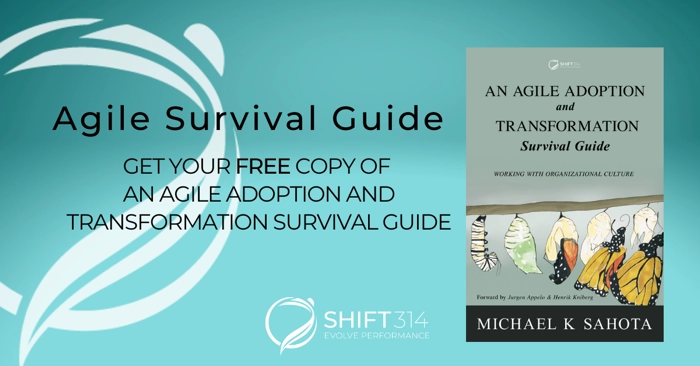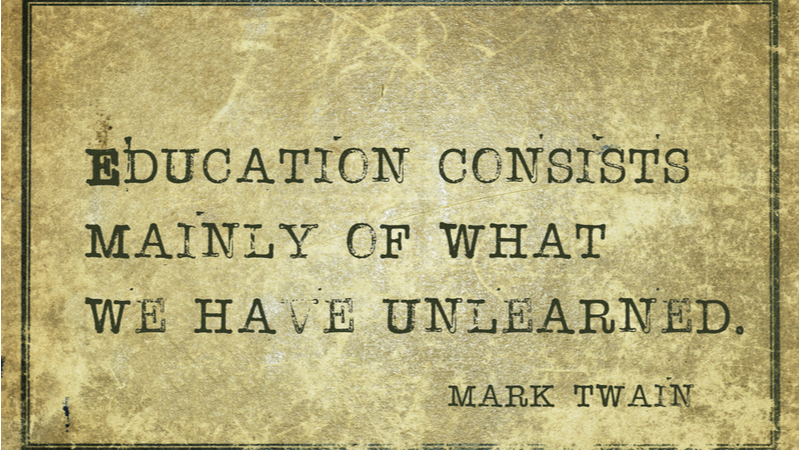The idea of Agile learning comes from the Agile Manifesto. The top line of the Agile Manifesto is, in many ways, the most important part. It says: “We are uncovering better ways of developing software by doing it and helping others do it.”
This is pointing to a kind of learning that creates tangible results and successes.
It speaks to running experiments, having successful outcomes, learning and then teaching others.
We can tell that Agile learning has taken place because we’re seeing a difference in outcomes. At its core, Agile is about a learning culture: uncovering better ways of working to create success.

There are two different kinds of learning in Agile: internal – about people – and external: process, systems and practices. Most of the focus is usually on the external. The question is how do we learn, as a team, to function better together? The answer is usually some form of external learning. For example, what can we do in terms of our process, how we work together, how we’re approaching the work that’s coming in, and how we’re building our products together? The answer to these questions usually has something to do with iterative learning.
What Is Iterative Learning?
One key concept in Agile is building things in iterations. This is also called iterative learning, which is learning as we go. It’s based on the understanding that at the beginning of a project, we’re not going to know as much as we’ll know in the future, and we can refine what we’re building through our learning. Because tomorrow, next week, or next month we’ll be smarter. We’ll have more knowledge to make better decisions about what will help us be successful and truly fulfill the customer’s needs.
The iterative learning process makes sure that we’re actually doing things that are going to hit the mark and create value. This is very, very different from traditional thinking. The traditional thinking is, “We’ll do all the analysis, we’ll figure it out, and then we’ll have a build phase where we go build it.” Iterative learning is based on an understanding that sometimes we can do that, but for most complex undertakings, we actually need to iterate. That’s because the core mechanism of delivering a complex project is learning.

The Story of the Rebuild
Imagine it’s December 20th. The team has had an amazing year. They’ve built an incredible project and they’re ready to ship it. It will be launched on January 1st. Everyone’s feeling good, and they’re celebrating at the Christmas party. While they’re at the Christmas party, the office burns down, and they discover all the backups they’d created are gone. All their work for the last year is destroyed.
So, what happens? They have to rewrite the whole project from scratch. There’s nothing that they can reuse from what they created that whole year. So, the question is, how long will it take them to rebuild the project? Will it take the same amount of time? Will it take less or more time?
We’ve actually asked this of experienced professionals, and have discovered there is an answer. While it depends a lot on the context, the average is usually around seven months.
If you’re the executive in charge of this, you might say, “Well, Jesus, if you can build it in seven months now, why didn’t you build it in seven months before?”

And the team says, “Well, before, we didn’t know all the business requirements inside and out. We didn’t know all the technical design decisions inside and out. We didn’t know exactly what our customers wanted, or even what the right things to build were. We didn’t have all the skills, knowledge, wisdom, and capacity to deliver things that we have now. The other five months were spent learning. Learning how to do our jobs more effectively, learning about the technical architecture, and learning about the customer needs.”
An Agile learning culture is about intentionally building and time to learn throughout the entire process.
What Is an Agile Learning Culture?
Agile learning culture has two parts: external and internal. External learning refers to learning about the world external to ourselves: the process, work practice, work coordination, etc. Internal learning is about who we are, how we show up as human beings, how we can improve collaboration. Faster, better, smarter. While there are two parts to a learning culture, we will explain an external learning culture first, since this is what people usually associate with Agile. The deeper and more important element of an internal learning culture will be explained later.

Even improving on a single area such as collaboration has both internal and external aspects. Externally we can talk about practices, facilitation, and be very particular about what activities will improve collaborations. When within the team members, we see the blocks to collaboration are manyfold such as fear of asking for help, an unwillingness to admit an error, wanting to look like the smartest person in the room. Ultimately, the external aspect is a reflection of the inner.
The external aspect is actually a reflection of the culture. If learning is valued in the organizational culture, you’ll see that reflected in the organization’s structures. There will be time and a budget for learning, which may include things like training programs, support from coaches, and a psychologically safe environment.
The internal aspect is a choice to evolve ourselves, which we also refer to as Evolutionary Leadership. Our core definition of Evolutionary Leadership is the choice to evolve one’s consciousness and learn better patterns of interacting with people and organizational systems. As human beings, it’s about learning what our ego is doing and how it is blocking our success. Our view is that without Evolutionary Leadership, Agile is just a hollow concept – or at best, it’s a starter kit. There is no way to fully realize other Agile values without an inner shift of being.
How to Create an Agile Learning Culture
First, let’s look at the external aspect of creating an Agile learning culture: the structures that support learning.

Creating the Space and Time for Learning
One of the most important steps you can take to create an Agile learning culture is to create space and time for learning. What does that mean?
For example, at one company we worked with, it meant creating a time code for learning. At that company, everyone had to do their 40 hours a week, and they had to have a time code for every minute of those 40 hours. The trouble was, there was no time code for learning. There was no space for learning in that organization until they changed the structures to allow it.
If you think about the opposite extreme, there’s Google’s 20% time, where 20% of the time people can do whatever they want – experiment, learn, try things out. The best thing leaders can do is create the space and time for learning.
Make Sure There’s Time for Experiments
It’s vital to make sure there’s enough buffer time for experiments that could end up making a much better product. As a project manager, product owner, or stakeholder, make sure there’s time for learning and experimentation.
This was actually the original intent of Agile. Unfortunately, Agile has turned into this death-march project, iteration by iteration, grinding out the code, getting the features done. That’s not the way it was originally conceived. It was designed to give the team space to explore and to achieve greatness – and greatness can only be achieved when there is space and time for learning.

Leaders Run Experiments and Report on Results
As discussed in the previous step, experiments are a powerful way of learning. But the only way to create a culture where it’s safe to run experiments is for leaders to model it themselves – and then report on the results.
For example, a leader might say, “Hey, we didn’t know if this was going to work, and it did, and this is what happened.” Or, “Hey, we tried this out. We weren’t sure if it would work, and wow, what a total failure. Here’s what we learned from it.” By running experiments and sharing the results, you will actually be modeling a learning culture and create a culture where it is safe to try experiments, safe to take a risk, and safe to learn.
Notice how we did not say “safe to fail”, a favorite in the Agile space. While we can learn from failure- if you’re discussing failure right out of the gate- chances are the experiment will fail. When you have psychological safety, use good data, and make choices in an environment where there is space and time for learning, experiments have a great opportunity for success (we created this teaching based on quantum physics “observer effect”). We say “good enough and safe to try,” with the intention of successful results.
The Inner Work of Creating an Agile Learning Culture
From an individual perspective, creating an Agile learning culture is about being really honest with yourself about where you are on your journey of evolution. Where are you in terms of being able to collaborate with and celebrate others? Are you genuinely open to learning, willing to admit your errors, and willing to ask for help?
Modeling these qualities is the foundation of creating an Agile learning culture. So how do you get there?

4A’s Leadership Model
We’ve created a very powerful technology to help create these behavioral shifts. The 4A’s Leadership Model helps to support behavioral change. It offers a way to identify growth edges and work through them. Without really a powerful tool or technology to evolve our behaviors, talking about moving to an Agile mindset is just lip service and good intentions. Technology like the 4A’s moves beyond the surface level and addresses the root issues that are blocking a real Agile learning culture.
Emotional Science
Another powerful resource for creating this inner shift is our work with Emotional Science. One of the biggest blocks for us to learn and evolve is our emotional system. The challenge for a lot of us is that we’re not able to learn because our fight or flight system takes over and the frontal cortex shuts off. We’re not open to learning because we’re functioning at the level of basic survival.
In the workplace, this is often called “stress” or “pressure for a deadline.” There are a lot of other candy-coated euphemisms we use to talk about it, but in essence, it’s a lack of psychological safety. Learning to surf our emotions more effectively and recover from challenging emotions when they arise can put us back into a resourced state where learning is possible.

Unlearning
The other technology, which we describe in detail in our forthcoming book, Leading Beyond Change, is the technology of unlearning. Unlearning is actually the most powerful form of learning.
The simplest way to begin unlearning is to practice holding conflicting ideas or beliefs in your mind without committing to either. According to F. Scott Fitzgerald, “The test of a first-rate intelligence is the ability to hold two opposed ideas in mind at the same time and still retain the ability to function.” You can start this today.
Agile Is a Culture System
Everything in this article is pointing you to the fact that Agile is a culture system. Attempting to use Agile without creating a coherent shift in your organizational culture will simply create a failed Agile transformation program.
And you can begin today, without authority, power, or budget. Your culture system and organization can be as small as yourself, your team, your department. You do not need to depend on leadership to create the culture of your organization. Choose to show up as a leader and begin to create the environment that will impact the success of your project, your team, and the greater organization.
We here at SHIFT314 have pioneered an evolutionary approach to culture shift in a way that creates an environment where Agile can thrive.
For a deeper understanding of how Agile is a culture system, we refer you to a complimentary download of our widely acclaimed book, An Agile Adoption and Transformation Survival Guide, by Michael K Sahota. We also have an introduction on how to approach your Agile transformation from the perspective of a learning culture – please see the free download Your Agile Transformation Keys white paper.



